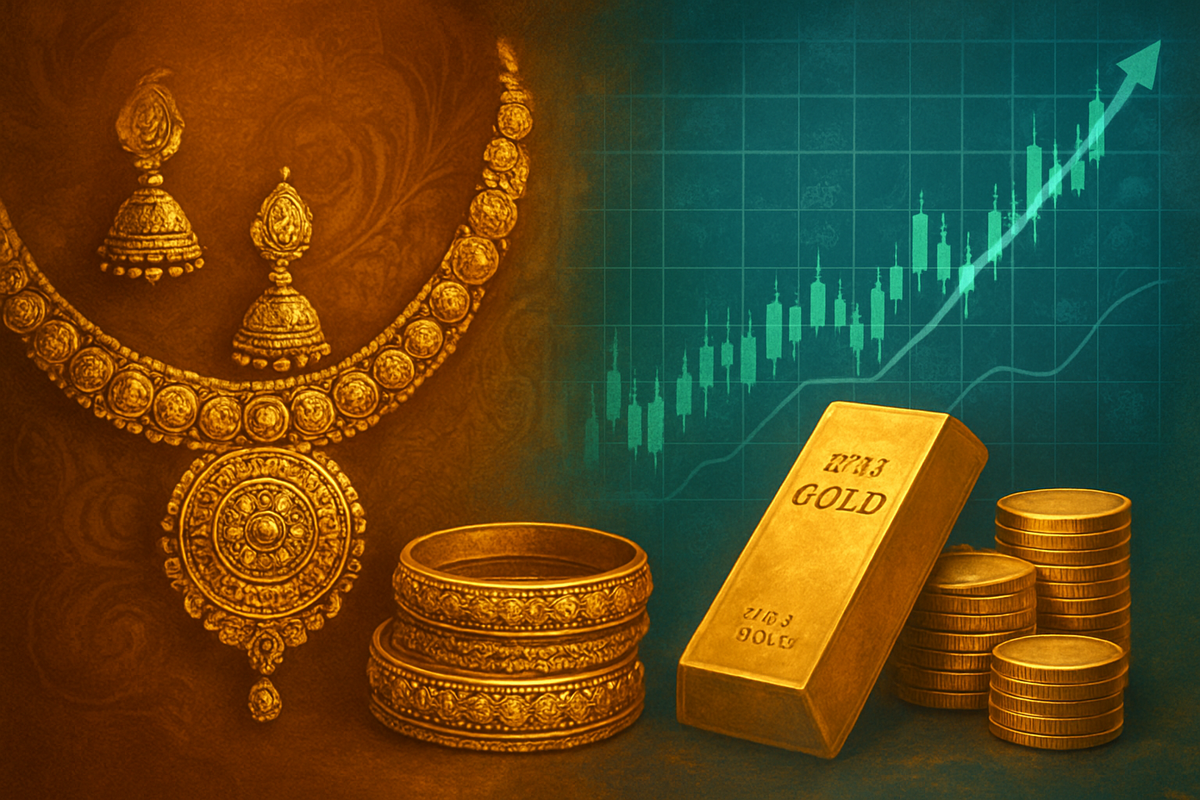
The Indian gold market is experiencing a profound transformation in late 2025, moving away from its centuries-old tradition of physical gold for ornamental and cultural purposes towards a more investment-centric approach. This significant pivot is fueled by a perfect storm of record-high gold prices, escalating global economic uncertainties, and evolving consumer preferences. The immediate implication is a moderation in physical gold demand by volume, juxtaposed with a surge in financialized gold products like Gold Exchange Traded Funds (ETFs) and Sovereign Gold Bonds, reshaping both domestic consumption patterns and India's influence on the global gold market.
The Golden Shift: A Deep Dive into India's Evolving Demand
The Indian gold market in late 2025 is defined by unprecedented price levels, with 24-karat gold nearing ₹127,900 per 10 grams and global prices surpassing $4,000 per ounce. This meteoric rise, seeing domestic prices surge 66% year-to-date and international prices up 58% by October 2025, has fundamentally altered consumer behavior. While India's deep-rooted cultural affinity for gold persists, overall gold demand in terms of volume is projected to be between 600 and 700 metric tons for 2025 by the World Gold Council, a five-year low. Despite this volume contraction, the total value of gold purchased has soared, increasing 23% in Q3 2025, highlighting the dominance of price appreciation.
The most striking aspect of this shift is the pronounced financialization of gold. Gold is increasingly perceived as a strategic safe-haven asset, a hedge against global economic uncertainty, geopolitical tensions, and inflationary pressures. This is starkly evident in the declining jewelry demand by volume, which saw a 31% year-on-year reduction in Q3 2025, falling to 117.7 tonnes. Conversely, investment demand for gold in forms like coins, bars, Gold ETFs, and digital gold has seen a robust surge. Purchases of physical gold coins and bars increased by 20% in volume and a massive 74% in value in Q3 2025.
The Gold ETF market in India is witnessing unprecedented growth. September 2025 recorded a record inflow of $902 million, adding 7.3 tons of gold to ETF holdings and pushing total holdings to a record 77.3 tons. Assets under management (AUM) for gold ETFs reached an all-time high of $10 billion in September 2025, growing to ₹1,021 billion ($11.5 billion) by October 2025, with nearly a third of total gold holdings added in 2025 alone. This growth is fueled by underperforming equity markets (Nifty 50 Index gained only 6% YTD in 2025) and gold's skyrocketing prices (60% gain YTD in 2025). Sovereign Gold Bonds (SGBs), while likely discontinued for new issues, have delivered impressive returns on redeemed series, further cementing gold's investment appeal. The Reserve Bank of India (RBI) also continues its strategic accumulation, with gold reserves reaching 880.2 tonnes by September 2025, and gold's share in India's foreign exchange reserves rising from 9% to 14% due to valuation gains.
Key players involved include individual investors shifting their portfolios, major financial institutions offering gold investment products, and the Indian government through its SGB scheme and the RBI's reserve management. Jewelers are adapting by offering lighter, design-centric pieces and promoting exchange schemes, with 40-45% of purchases involving old jewelry trade-ins. The initial market reaction has been a recalibration, with traditional gold retailers facing pressure on volume sales but seeing an uplift in value, while financial product providers are experiencing a boom. This shift is also reinforcing the global gold price rally, with India's robust investment demand contributing to gold's sustained appeal worldwide.
Winners and Losers: Corporate Impact of the Investment Shift
The profound shift in the Indian gold market towards investment buying is creating a clear dichotomy: a challenging environment for traditional jewelers and a lucrative opportunity for financial institutions and asset managers.
Traditional jewelers, heavily reliant on high-carat physical gold jewelry, are facing significant headwinds. Companies like Titan Company Ltd. (NSE: TITAN), with its prominent Tanishq brand, will experience mixed impacts. While its strong brand and diversified portfolio, including brands like Mia and Zoya, offer some resilience, the volume of traditional jewelry sales is under pressure. Its online platform, CaratLane, might see traction for fashion jewelry, but the core gold segment requires adaptation. Similarly, Kalyan Jewellers India Ltd. (NSE: KALYANKJIL) and regional players like Thangamayil Jewellery Ltd. (NSE: THANGAMAYL) will need to pivot their offerings towards lighter, more contemporary designs and potentially explore investment-grade products to mitigate the decline in traditional heavy gold purchases. Rajesh Exports Ltd. (NSE: RAJESHEXPO), a major refiner and exporter, might see a mixed impact, with its refining operations potentially benefiting from increased investment demand, even as its retail segment faces challenges. Goldiam International Ltd. (NSE: GOLDIAM) might be less affected due to its focus on diamond-studded jewelry, but a general slowdown in luxury spending due to high gold prices could still pose a challenge. A clear winner among physical gold facilitators is MMTC Ltd. (NSE: MMTC), a government-backed importer and trader of gold bullion, whose operations directly benefit from increased demand for gold coins and bars for investment. Its stake in MMTC-PAMP India Pvt. Ltd. further strengthens its position in investment-grade gold products.
Conversely, financial institutions and asset managers are poised to be significant beneficiaries. Gold loan Non-Banking Financial Companies (NBFCs) such as Muthoot Finance Ltd. (NSE: MUTHOOTFIN) and Manappuram Finance Ltd. (NSE: MANAPPURAM) are clear winners. Higher gold prices increase the value of the collateral backing their loans, strengthening their balance sheets and allowing for larger loan disbursements, boosting their core business model and revenues. Major banks like HDFC Bank (NSE: HDFCBANK), State Bank of India (NSE: SBIN), ICICI Bank (NSE: ICICIBANK), and Bank of Baroda (NSE: BANKBARODA) will also benefit from increased sales of investment-grade gold coins and bars, as well as from their gold loan offerings. Jio Financial Services Ltd. (NSE: JIOFIN) is strategically positioned to capture the burgeoning digital gold market with its focus on digital financial products, attracting a new generation of investors.
Asset management companies (AMCs) are experiencing a boom. Funds like Nippon India Gold ETF (NSE: NIPPONIND), SBI Gold Fund, ICICI Prudential Regular Gold Savings Fund, and numerous other gold ETFs and gold mutual funds are witnessing unprecedented inflows. As of October 2025, the AUM of gold ETFs has climbed to a record ₹1,021 billion (US$11.5 billion), directly translating to higher management fees and significantly boosting their revenues. These AMCs are solidifying their positions as preferred platforms for gold investment, catering to the growing demand for financialized gold products.
Wider Significance: Gold's Global Reaffirmation
India's decisive pivot towards investment-oriented gold buying in late 2025 is not an isolated event but a significant development that resonates with and amplifies broader global trends in the precious metals industry. This transformation underscores gold's enduring role as a strategic asset in an increasingly volatile world.
This Indian shift aligns perfectly with the surging global gold prices observed throughout 2024 and 2025, driven by persistent geopolitical tensions, uncertain macroeconomic policies, and a weaker US dollar. It also mirrors the consistent accumulation of gold by central banks worldwide, particularly in emerging markets, as they diversify reserves away from the US dollar and seek greater financial autonomy. This institutional demand, coupled with India's burgeoning investment appetite, provides a strong structural support for gold prices globally. The increased popularity of Gold ETFs, both in India and internationally, further signifies a global preference for securitized and liquid gold investments. Historically, the global gold market experienced a similar shift post-2008 financial crisis, where gold's safe-haven appeal surged, demonstrating its consistent role during economic instability.
The ripple effects of India's evolving gold demand are substantial. On international gold markets, India's sustained investment buying will significantly amplify global demand, contributing to higher international gold prices and potentially increasing market volatility as a major consumer base alters its buying patterns. For gold mining companies, higher prices directly translate to increased profitability, incentivizing them to boost production and invest in exploration. This could lead to a long-term increase in global gold supply. Regarding other financial assets, India's shift suggests a growing prioritization of wealth preservation and risk mitigation. This could lead to a reallocation of funds from more volatile assets like equities and bonds into gold during periods of uncertainty, given gold's inverse correlation with equity markets. Increased gold imports, even for investment, could also exert pressure on India's current account deficit and the Indian Rupee.
Regulatory and policy implications are also noteworthy. India has historically intervened in its gold market to manage imports. While recent policy changes, such as the reduction of import duties in 2024-25, aimed to boost legal imports, the government continues to monitor and adjust these to balance legitimate investment with controlling overall import volumes. Schemes like the Gold Monetization Scheme (GMS) are being re-evaluated, with the Ministry of Finance discontinuing some deposit options. The Basel III framework, with full compliance by January 1, 2026, is a critical global regulatory development. By requiring banks to maintain 100% backing for gold positions, it could increase the cost of unallocated gold trading and encourage physically-backed trading, potentially leading to a structural upward repricing of gold globally. India's own history, including the Gold Control Act of 1968 and its repeal in 1990, offers precedents for how policy changes can dramatically reshape market dynamics.
What Comes Next: Navigating Gold's Future Landscape
The Indian gold market stands at a pivotal juncture, with its investment-centric future promising both significant opportunities and challenges for various stakeholders. The trajectory for the coming months and years points towards a deepening financialization of gold within India and its continued influence on global dynamics.
In the short term (late 2025 to early 2026), physical jewelry sales by volume are expected to continue facing headwinds, with a projected decline of 10-15%. However, the sheer increase in gold prices will ensure that demand in value terms remains substantially higher. Investment demand, particularly for gold coins, bars, ETFs, and digital gold, is poised for continued robust growth. Long term (beyond 2026), the outlook suggests a sustained structural shift, with gold prices potentially breaching ₹150,000 per 10 grams by 2026 and ranging between ₹140,000 and ₹225,000 per 10 grams by 2030, driven by ongoing global uncertainties and a depreciating Indian Rupee.
Strategic pivots are imperative for jewelers, who must adapt by focusing on lighter, lower-carat, and more investment-oriented designs. They will need to embrace omnichannel sales approaches and educate customers on gold's value as a safe-haven asset. Financial institutions are tasked with developing and promoting a wider array of gold-backed financial products, expanding gold loan services, and potentially building out bullion banking capabilities. The government's role is critical in strengthening regulatory frameworks, revamping gold monetization schemes to mobilize India's vast idle gold, and exploring domestic mining to reduce import dependency. Rationalizing import duties and promoting awareness of financial gold products will also be key.
New market opportunities abound, particularly in the growth of digital gold and ETFs, the expansion of the gold loan market, and the increasing dominance of organized retail in the jewelry sector. However, challenges include the persistent decline in physical jewelry demand by volume, inventory management risks due to price volatility, India's high import dependency, and the uncertainty surrounding policy changes.
Potential scenarios for the Indian gold market include a "Continued Financialization with Steady Growth," where gold solidifies its role as an investment asset, leading to a more mature and diversified market. Another scenario is "Price Volatility and Demand Fluctuations," where geopolitical events cause significant price swings, impacting both investment and jewelry demand. A more optimistic "Enhanced Domestic Value Chain and Reduced Imports" scenario could see government initiatives in mining and refining gaining traction, making India more self-sufficient. Globally, India's sustained investment demand could cement its role as a "Global Investment Powerhouse," significantly influencing international gold prices, or it could remain a "Domestic Focus with Moderate Global Impact," where global prices are more swayed by major international economic policies.
Wrap-up: Gold's Enduring Appeal in a Changing India
The Indian gold market, as of late 2025, is undergoing a monumental transformation, shifting from its centuries-old cultural and ornamental stronghold to a modern investment powerhouse. This paradigm shift, driven by record-high gold prices, geopolitical instability, inflationary pressures, and a depreciating Indian Rupee, has reshaped consumption patterns and solidified gold's position as a crucial financial asset.
The key takeaway is the unprecedented surge in investment buying, particularly in gold bars, coins, and Exchange Traded Funds (ETFs), which now accounts for a record 40% of total gold consumption. This robust demand for financialized gold products stands in stark contrast to the dampened traditional jewelry demand, highlighting a fundamental change in how Indians perceive and utilize gold. Gold is no longer merely an adornment; it is a strategic tool for wealth preservation and portfolio diversification, even for those with limited prior exposure.
Moving forward, the market trajectory indicates persistent strength in investment demand, with gold prices expected to remain elevated, potentially reaching ₹140,000 to ₹225,000 per 10 grams by 2030. This sustained bullish sentiment underscores gold's outperformance against other asset classes in 2025 and its continued role as a reliable hedge against global volatility. The modernization of gold investment through digital platforms and ETFs is set to deepen, offering accessible and liquid alternatives to physical gold, thereby evolving its cultural role to encompass significant financial utility. Economically, while increased gold imports could impact India's current account deficit, the Reserve Bank of India's strategic accumulation helps diversify foreign exchange reserves. India's influence as a pivotal driver of global gold demand will undoubtedly continue, shaping international prices and market dynamics.
For investors in the coming months (late 2025 - early 2026), vigilance is key. Monitoring global central bank policies, particularly those of the US Federal Reserve, for cues on interest rates and monetary easing, is crucial as these significantly impact gold prices. Tracking USD-INR fluctuations and domestic inflation trends will also provide valuable insights into local gold price dynamics. Considering diversification through gold ETFs and digital gold offers convenient, liquid, and professionally managed options for those seeking to invest without the complexities of physical gold. While gold prices have seen some recent softening, analysts often advise accumulating on dips, targeting further appreciation in the medium to long term. Finally, staying abreast of any potential policy changes regarding customs duty or GST on gold, as well as observing geopolitical developments, will be essential for navigating this evolving market.
This content is intended for informational purposes only and is not financial advice





